In today’s digital landscape, startups can harness the power of social media for effective brand development by crafting engaging content and fostering community interaction. By implementing targeted advertising and collaborating with influencers, they can significantly expand their audience reach and enhance brand visibility. Utilizing the right tools and platforms not only streamlines management but also provides valuable insights, ultimately leading to a stronger online presence.

How can startups leverage social media for brand development?
Startups can effectively leverage social media for brand development by creating engaging content, building a community, and interacting with their audience. This approach helps in increasing visibility, fostering loyalty, and establishing a strong brand identity.
Utilizing Instagram for visual storytelling
Instagram is a powerful platform for startups to showcase their brand through visual storytelling. High-quality images and videos can highlight products, share behind-the-scenes content, and convey the brand’s values and mission.
To maximize impact, use features like Stories, Reels, and IGTV. Consistent posting and engaging with followers through comments and direct messages can enhance brand perception and customer loyalty.
Engaging audiences on Twitter through conversations
Twitter is ideal for real-time engagement and conversations with your audience. Startups can use this platform to share updates, respond to customer inquiries, and participate in trending topics relevant to their industry.
Utilize hashtags strategically to increase visibility and join conversations. Regularly engaging with followers through polls, questions, and retweets can foster a sense of community and keep your brand top-of-mind.
Building community on Facebook Groups
Facebook Groups offer a unique opportunity for startups to build a dedicated community around their brand. By creating a group, businesses can engage directly with their audience, share valuable content, and encourage discussions.
Focus on providing value through exclusive content, resources, and support. Regular interaction and moderation are essential to maintain a positive environment that encourages member participation and loyalty.
Using LinkedIn for professional networking
LinkedIn is a key platform for startups aiming to connect with professionals and industry leaders. By sharing insightful articles, engaging in discussions, and networking with other businesses, startups can enhance their credibility and visibility.
Consider joining relevant industry groups and participating in discussions to establish authority. Regularly updating your company page with achievements and milestones can attract potential partners and clients, further aiding brand development.
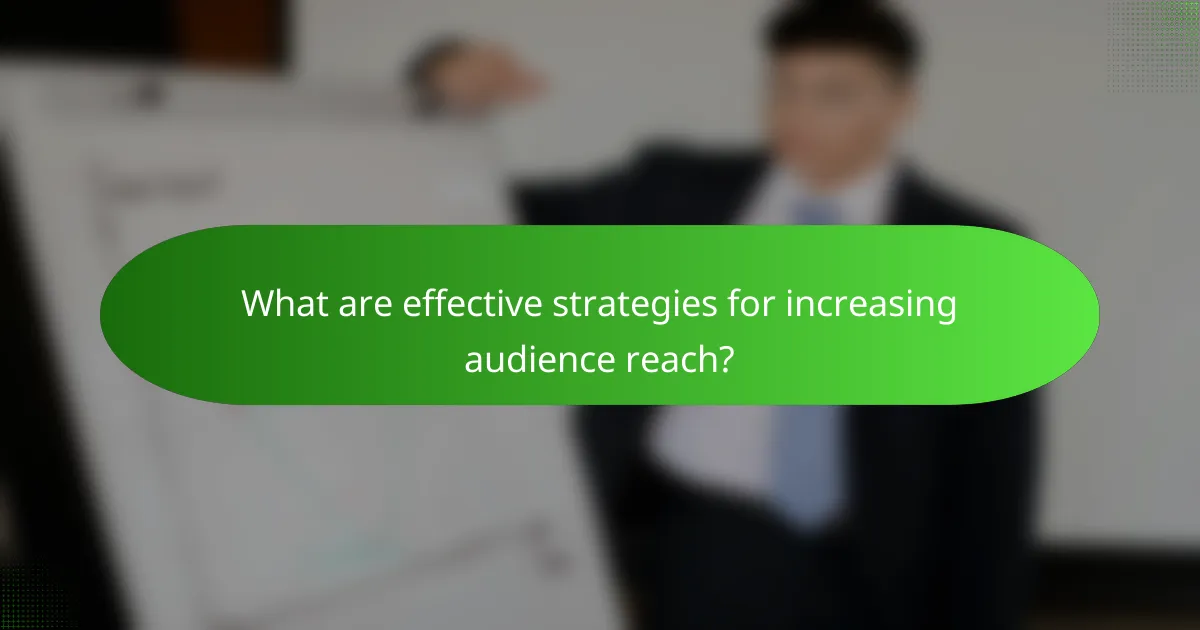
What are effective strategies for increasing audience reach?
Effective strategies for increasing audience reach include targeted advertising, creating shareable content, and collaborating with influencers. These approaches help startups connect with their desired audience more efficiently and expand their visibility across social media platforms.
Implementing targeted advertising on social platforms
Targeted advertising allows businesses to reach specific demographics based on interests, behaviors, and location. Platforms like Facebook and Instagram offer robust targeting options, enabling startups to allocate their advertising budget effectively. For example, a startup could target ads to users aged 25-35 interested in fitness within a certain city.
When creating ads, focus on clear messaging and strong visuals to capture attention quickly. A/B testing different ad formats can help identify what resonates best with your audience. Avoid broad targeting that may dilute your message and waste resources.
Creating shareable content to boost organic reach
Shareable content is designed to engage users and encourage them to distribute it within their networks. This can include informative articles, entertaining videos, or eye-catching infographics. The key is to create content that provides value or evokes emotion, prompting users to share it.
Utilize social media trends and hashtags to increase the likelihood of your content being shared. Regularly analyze which types of content perform best and refine your strategy accordingly. Don’t forget to include clear calls to action that encourage sharing.
Collaborating with influencers for broader exposure
Influencer collaborations can significantly enhance your brand’s reach by leveraging the established audiences of popular figures. Startups should identify influencers whose values align with their brand and who have a genuine connection with their followers. This can lead to authentic endorsements that resonate more with potential customers.
When approaching influencers, be clear about your goals and what you can offer in return, whether it’s monetary compensation or free products. Monitor the performance of influencer campaigns to assess their impact on your audience reach and adjust your strategy as needed. Avoid partnering with influencers solely based on follower count; engagement rates are often a better indicator of potential success.
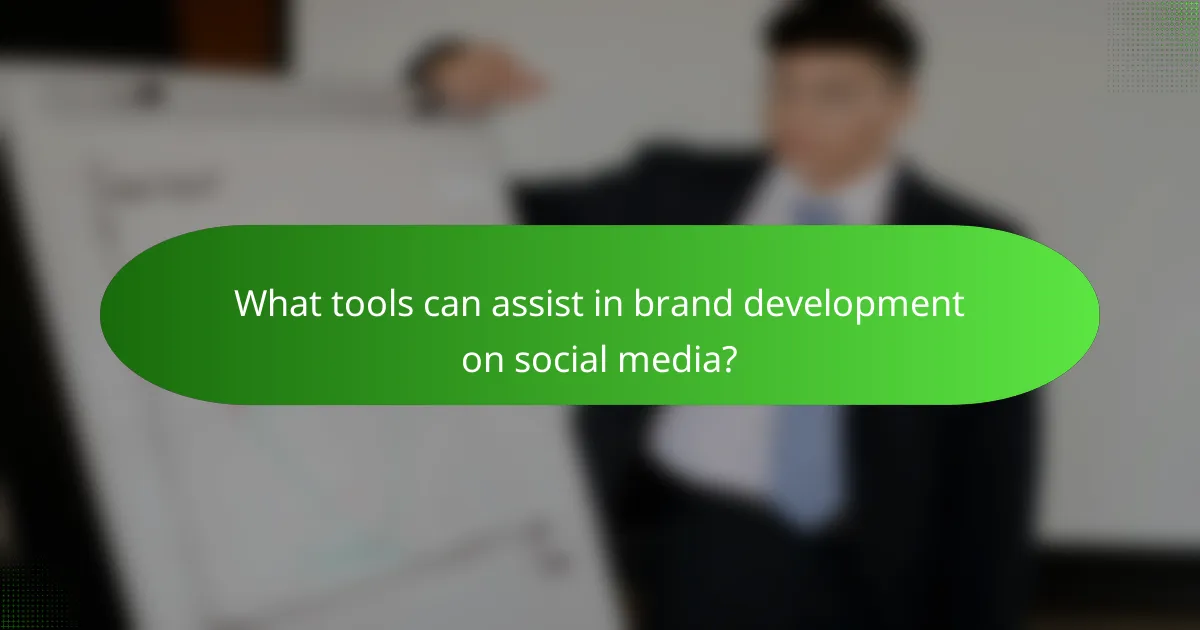
What tools can assist in brand development on social media?
Several tools can enhance brand development on social media by streamlining management, improving design, and providing audience insights. Utilizing the right platforms can lead to better engagement and a stronger brand presence online.
Using Hootsuite for social media management
Hootsuite is a comprehensive social media management tool that allows users to schedule posts, track engagement, and analyze performance across various platforms. By centralizing your social media activities, you can save time and ensure consistent messaging.
To effectively use Hootsuite, start by connecting your social media accounts and creating a content calendar. This helps in planning your posts and maintaining a steady flow of content. Regularly review analytics to adjust your strategy based on what resonates with your audience.
Employing Canva for graphic design
Canva is a user-friendly graphic design tool that enables users to create visually appealing content for social media. With a wide range of templates and design elements, it simplifies the process of producing professional-quality graphics without needing extensive design skills.
When using Canva, focus on maintaining brand consistency by using your brand colors, fonts, and logos. Regularly update your designs to keep your content fresh and engaging. Consider creating a library of templates for different types of posts to streamline your workflow.
Leveraging Google Analytics for audience insights
Google Analytics is a powerful tool for gathering insights about your audience’s behavior and preferences. By tracking metrics such as website traffic, user demographics, and engagement patterns, you can make informed decisions to enhance your brand’s social media strategy.
To leverage Google Analytics effectively, set up goals that align with your brand objectives, such as increasing website visits or social media shares. Regularly analyze the data to identify trends and adjust your content strategy accordingly. This data-driven approach can significantly improve your audience reach and engagement.
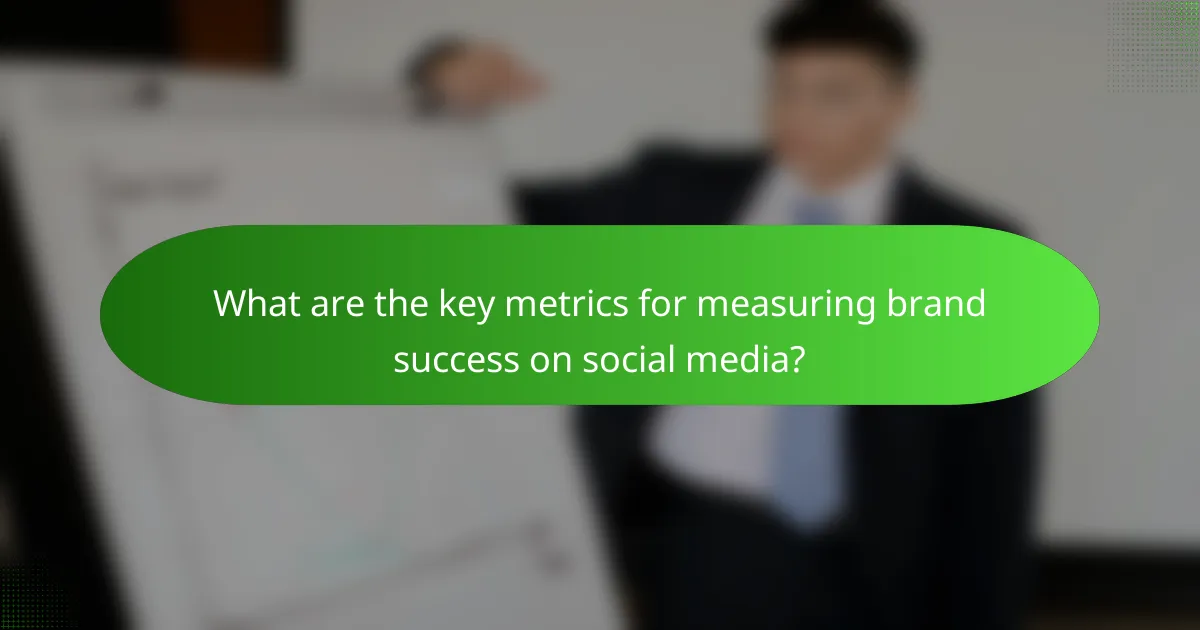
What are the key metrics for measuring brand success on social media?
Key metrics for measuring brand success on social media include engagement rates, follower growth, and conversion rates. These metrics provide insights into how well your brand resonates with its audience and the effectiveness of your social media strategies.
Tracking engagement rates across platforms
Engagement rates reflect how actively users interact with your content, including likes, shares, comments, and saves. A high engagement rate indicates that your audience finds your content relevant and appealing. Aim for engagement rates of around 1% to 5% depending on the platform, as this range is generally considered healthy.
To track engagement effectively, use analytics tools provided by social media platforms or third-party applications. Regularly review which types of content generate the most interaction, and adjust your strategy accordingly to enhance engagement.
Analyzing follower growth over time
Follower growth is a crucial metric that shows how your audience is expanding. A steady increase in followers indicates that your brand is gaining visibility and attracting interest. Monitor your follower count weekly or monthly to identify trends and spikes that correlate with specific campaigns or content types.
Consider using a line graph to visualize follower growth over time. This can help you pinpoint successful strategies or campaigns and understand when your audience is most responsive. Aim for a growth rate of 5% to 10% monthly as a benchmark for healthy expansion.
Monitoring conversion rates from social campaigns
Conversion rates measure how effectively your social media campaigns drive desired actions, such as purchases, sign-ups, or downloads. A strong conversion rate indicates that your messaging and targeting are effective. Typical conversion rates can vary widely, but a range of 1% to 3% is often considered average for social media marketing.
To improve conversion rates, ensure your calls to action are clear and compelling. Test different approaches, such as varying your messaging or visuals, to see what resonates best with your audience. Regularly analyze the performance of your campaigns to refine your strategies and maximize return on investment.
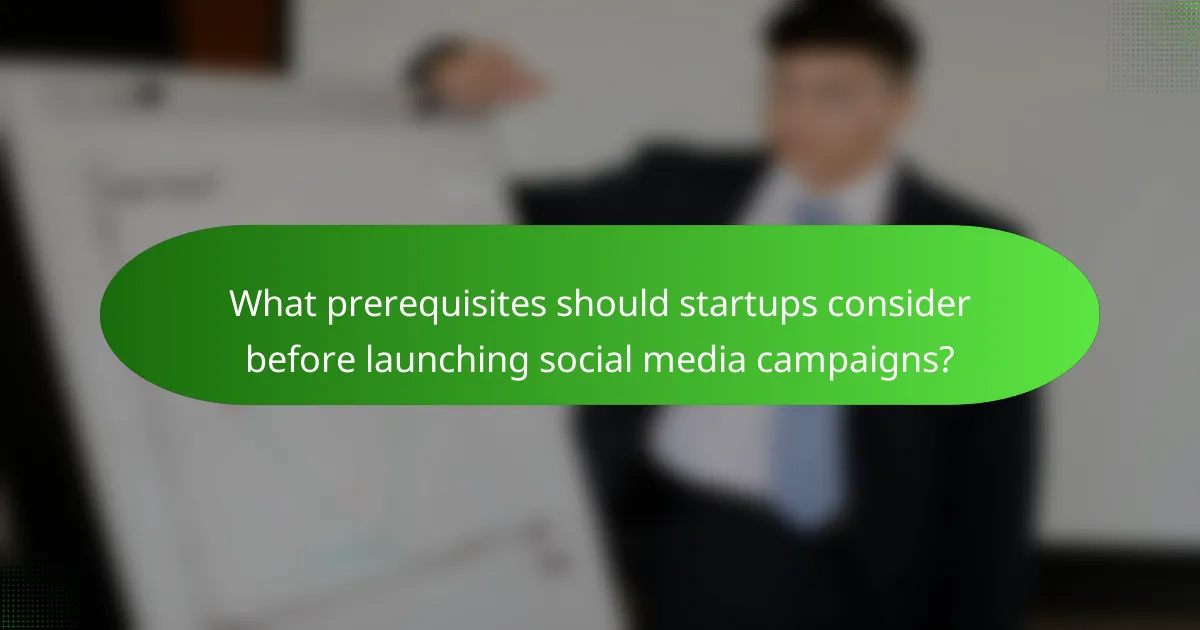
What prerequisites should startups consider before launching social media campaigns?
Startups should assess their goals, resources, and audience before initiating social media campaigns. Understanding these prerequisites helps in crafting effective strategies that resonate with potential customers.
Defining target audience demographics
Identifying target audience demographics is crucial for tailoring social media campaigns. Startups should consider factors such as age, gender, location, interests, and purchasing behavior to create relevant content.
Utilize tools like surveys or social media analytics to gather insights about your audience. This data can guide decisions on which platforms to use and what type of messaging will engage your audience effectively.
Establishing brand voice and messaging
Establishing a consistent brand voice and messaging is essential for building recognition and trust. Startups should define their brand personality—whether it’s professional, friendly, or quirky—and ensure that all communications reflect this tone.
Craft clear and concise messaging that aligns with your brand values. For example, if your startup focuses on sustainability, emphasize eco-friendly practices in your posts. Regularly review and adjust your messaging based on audience feedback and engagement metrics to maintain relevance.
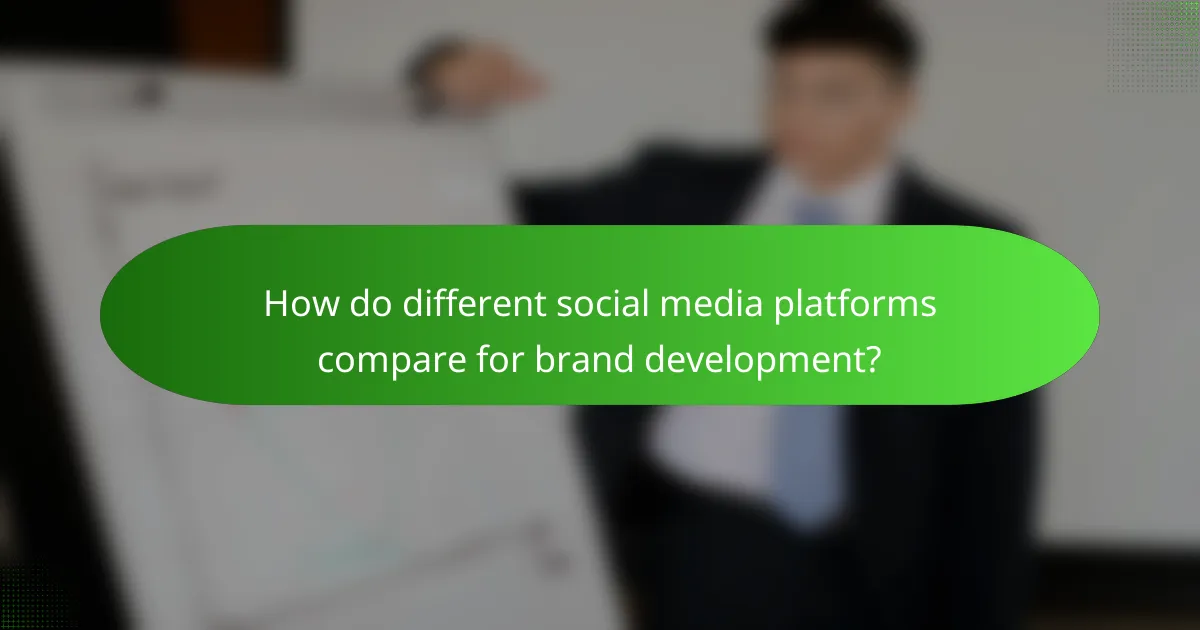
How do different social media platforms compare for brand development?
Different social media platforms offer unique advantages for brand development, depending on the target audience and content type. Understanding these differences can help startups effectively reach and engage their desired demographics.
Facebook vs. Instagram for visual brands
Facebook and Instagram both cater to visual brands but serve different purposes. Facebook is ideal for building community and sharing diverse content, while Instagram focuses on high-quality visuals and storytelling, making it more suitable for brands emphasizing aesthetics.
For visual brands, Instagram’s features like Stories, Reels, and shoppable posts can drive engagement and sales. In contrast, Facebook’s groups and events can foster deeper connections with audiences. Brands should consider their content strategy when choosing between these platforms.
To maximize impact, brands should maintain a consistent visual identity across both platforms. Regularly posting engaging content, utilizing hashtags effectively, and interacting with followers can enhance brand visibility and loyalty. Avoid neglecting one platform in favor of the other; instead, leverage their strengths for a comprehensive approach.
